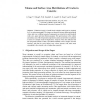Free Online Productivity Tools
i2Speak
i2Symbol
i2OCR
iTex2Img
iWeb2Print
iWeb2Shot
i2Type
iPdf2Split
iPdf2Merge
i2Bopomofo
i2Arabic
i2Style
i2Image
i2PDF
iLatex2Rtf
Sci2ools
129
click to vote
IWVF
2001
Springer
2001
Springer
Volume and Surface Area Distributions of Cracks in Concrete
Volumetric images of small mortar samples under load are acquired by X-ray microtomography. The images are binarized at many different threshold values, and over a million connected components are extracted at each threshold with a new, space and time efficient program. The rapid increase in the volume and surface area of the foreground components (cracks and air holes) is explained in terms of a simple model of digitization. Analysis of the data indicates that the foreground consists of thin, convoluted manifolds with a complex network topology, and that the crack surface area, whose increase with strain must correspond to the external work, is higher than expected. 1 Objectives and Scope of the Paper Many attempts to model or recognize shape and form are based on a bi-level representation of relatively simple objects. In contrast, we are faced with an engineering problem characterized by sequences of large, complex, volumetric gray-scale images. This data was produced by a unique im...
Computer Graphics | IWVF 2001 | Small Mortar Samples | Surface Area | Volumetric Gray-scale Images |
Related Content
| Added | 30 Jul 2010 |
| Updated | 30 Jul 2010 |
| Type | Conference |
| Year | 2001 |
| Where | IWVF |
| Authors | George Nagy, Tong Zhang, W. R. Franklin, Eric Landis, Edwin Nagy, Denis T. Keane |
Comments (0)

